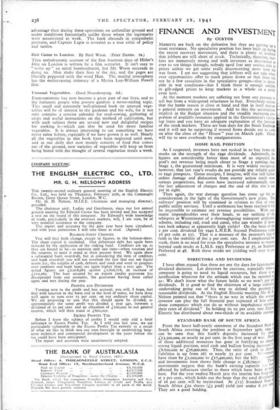FINANCE AND INVESTMENT
By CUSTOS
MARKETS are back on the defensive but they are putting up I stout resistance. No speculative position has been built up during the recent recovery movement, and there is plenty of evidence that jobbers are still short of stock. Technically, therefore, mar. kets are immensely strong and with investors as determined as ever to see things through, nobody need fear any serious slide in prices unless we get some really disconcerting news from the war front. I am not suggesting that jobbers will not take what. ever opportunities offer to mark prices down or that there will not be a few casualties in the speculative groups—that is inevit- able in war conditions—but I think there is enough stability in gilt-edged prices to keep markets as a whole on a pretty even keel.
At the moment markets are suffering not from any pressure to sell but from a widespread reluctance to buy. Everybody realises that the battle season is close at hand and that in itself imposes a general restraint on investment. Add to this the uncertainties implicit in the Budget situation and the steadily increasing pro. portion of available resources applied in the Government's various tap loans and you have an adequate explanation of the lassitude of the stock markets. These are lean days for the Stock Exchange and it will not be surprising if several firms decide not to carry on after the close of the " House " year on March 25th. Others will try to save overheads by amalgamations.
HOME RAIL POSITION
As I suspected, investors have not rushed in to buy home rall stocks on the strength of the 1940 dividends. Admittedly, the figures are considerably better than most of us expected, the pool's net revenue being much closer to Stage 2 earnings than Stage ,, the guaranteed minimum. It is very widely recognised, however, that last year's results do not provide any reliable guide to 1941 prospects. Gross receipts, I imagine, will rise still further unless damage and dislocation from enemy action reach more serious proportions, but costs have increased substantially since the last adjustment of charges and the end of this rise is not yet in sight.
Then again, the war damage question has come up for re- consideration in the light of the Government's new plans. The railways' position will be examined in relation to that of other public utility services. Until a settlement has been reached it is be impossible to estimate net revenue possibilities. With such major imponderables over their heads, to say nothing of the whispers at Westminster of a thoroughgoing transport unification scheme, including rail, road and canal, who can wonder if inves- tors look askance at apparently high yields? On the basis of the 2 per cent. dividend for 1940 L.N.E.R. Second Preference yields 16 per cent. at r2+. That is a measure of the investor's lack of faith in the stability of the 2 per cent. rate. As I emphasised lan week, there is no need for even the speculative investor to venture beyond such stocks as L.M.S. 1923 Preference at 37, or Southern Preferred at 48. Both these stocks are yielding well over to pea cent.
DIRECTORS AND DIVIDENDS
I have often argued that these are not the days for faint-hearted dividend decisions. Let directors be cautious, especially when company is going to need its liquid resources, but there 1510 justification whatever for the attitude which can be summedlIP as : We don't know what the future holds so we won't pay ane dividends. It is good to find the chairman of a large industrial undertaking going out of his way to defend the payment „d reasonable dividends. At the English Electric meeting Mr. G. It Nelson pointed out that " there is no way in which the average investor can play the full financial part expected of him unless those companies which can do so without impitelence malell21 their rates of dividend." In holding its to per cent. rate Enpi Electric has distributed about two-thirds of its available earnill STANDARD BANK OF SOUTH AFRICA From the latest half-yearly statement of the Standard Bank South Africa covering the position at September 3oth, 1940, can be seen that this bank's deposits increased by ab°111 £13,300,000, or nearly 20 per cent. in the first year of war. M of these additional resources has gone in fortifying an alt strong liquid position, total cash and bullion having increased £8,600,000 to £26,900,000. Thus, the ratio of cash to de liabilities is up from 26-1- to nearly 33 per cent. In—strn have risen by £2,000,000 to £17,400,000, but the bills -0_1111 and investments item shows little change at £38,700,o: movements suggest that the bank's earning capacity 11:3 affected by influences similar to those which have been at here. For the year ending Match 31st the interim has been k at 5 per cent., which holds out the hope that the total distal] of 16 per cent. will be maintained. At £131 Standard Bank South Africa £20 shares (£5 paid) yield just under 6 per They are a good holding.


























 Previous page
Previous page